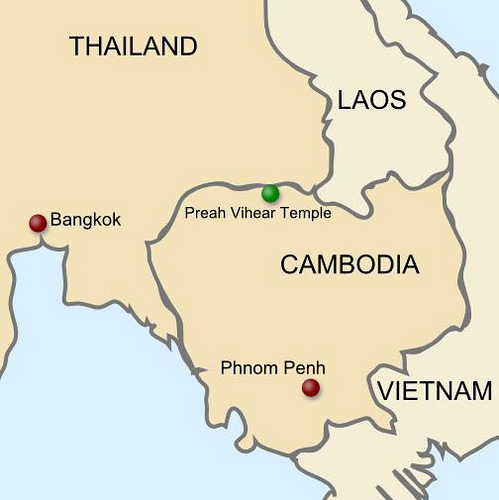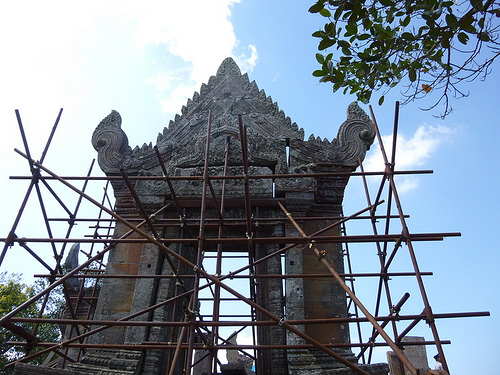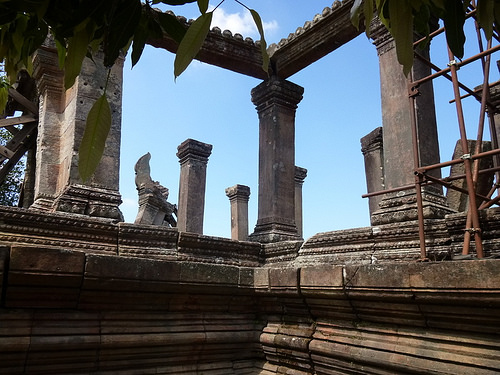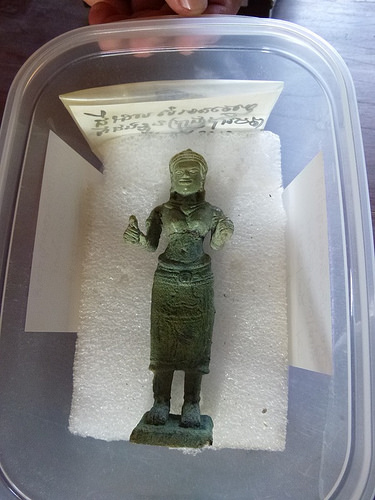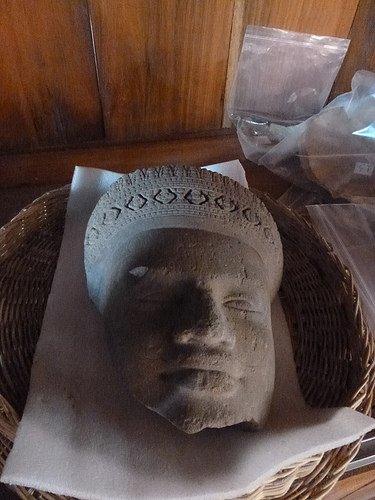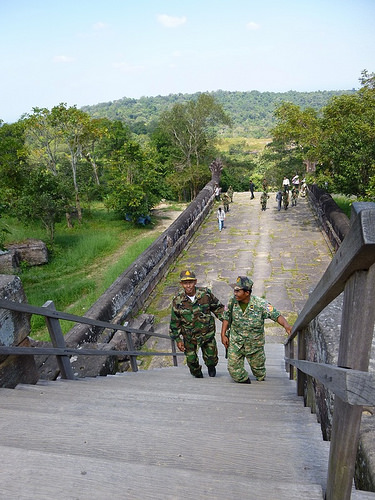Preah Vihear Province, Cambodia—Dozens of crates with ziplock bags populate the back room of a new museum near an Angkorian temple on the Thailand border. Each bag is carefully labeled in black marker, with the date and location of the artifact contained within. I can’t read Khmer, but I can see that many of the bags are marked with “2013” on them.
Acting Museum Director Seng Kompheak takes out a piece of pottery. “It looks like the face of a monkey because of the big ears,” he says.
From another bag, he removes a small stone object and turns it over—it’s a stamp depicting an image of a crocodile. “We had never seen this. It looks like a prehistoric tool,” he adds.
A large, partly broken jar rests on the table. “It was probably a burial jar,” Kompheak says, “because it has a small hole drilled in the bottom.”
These are some of the objects that will go on display at the Samdech Decho Hun Sen Eco-Global Museum of Preah Vihear, which is expected to open in early 2014. Named after, and funded in part by, Cambodia’s Prime Minister Hun Sen, the museum is dedicated to Cambodia’s second UNESCO World Heritage Site: the mountaintop temple, Prasat Preah Vihear, situated on the border between Thailand and Cambodia. It is an imposing structure, originally built to command a prominent place atop a 525-metre (1,722 ft) cliff in the Dângrêk Mountains during the reign of the Khmer Empire in the 11th-12th centuries C.E. Dedicated to the Hindu deity Shiva, it was known as “Shikareshvara” in Angkorian times.
Thailand and Cambodia have long disputed the ancient temple and the land surrounding it. In 1962, the Hague-based International Court of Justice ruled that the temple belongs to Cambodia—a decision some Thai nationalists did not accept. Fighting between Thai and Cambodian forces sparked up here in 2008 and in 2011, inflicting damage on the eleventh-century temple, which was hit by mortar and artillery shells. The Thais argued that, while the International Court of Justice ruled that the temple belongs to Cambodia, Thailand was not clear as to who owns the land around the ancient monument. To clarify the misunderstanding, the Court issued its final decision in November 2013, giving Cambodia sovereignty over the land around the temple, and ordering Thailand to withdraw its military from the area.
Located 500 km from Cambodia’s capital, the Preah Vihear Temple has long been inaccessible. Partly because of its remote location, Preah Vihear was among the last strongholds of the Khmer Rouge—civil war ended here only in 1998, and the area is still heavily mined. French colonial archaeologists couldn’t learn much about the site because of the land dispute with Thailand, according to Christiane Garnero Morena, a UNESCO expert who worked on the museum. It’s now impossible to get to the temple from the Thai side. The border has been closed since 2008, and visitors with Thai passports aren’t allowed to approach the temple.
__________________________________________
The Preah Vihear Temple straddles the border between Thailand and Cambodia
_________________________________________
________________________________
Above and below: Today, scaffolding is a visible reminder that Cambodian authorities are focusing efforts to manage and develop the site. Photo by Julie Masis
_________________________________________
___________________________________________
Perhaps because Preah Vihear Province has remained inaccessible to archaeologists, there’s a wealth of undiscovered history here. In the last five years, while digging trenches and building barricades, Cambodian soldiers came across dozens of Angkorian artifacts. The conscious effort on the part of the Cambodian government to develop the area for tourism has also helped; historic items were unearthed during road construction, or were returned to officials after villagers heard that a museum was being built.
“More than 500 pieces were found in the last few years,” said Pheng Sanoeun, director of the Department of Monuments and Archaeology at Cambodia’s National Authority for Preah Vihear. “We don’t count every single artifact. We are not interested in the number of pieces. We are interested in the pieces that give us new information.”
“The items were most likely left behind by the people who built the temple approximately a thousand years ago,” he added. Construction of the Preah Vihear Temple began in the ninth century, and lasted more than 200 years.
According to Philippe Delanghe, the culture specialist at UNESCO’s office in Phnom Penh, some of these newly discovered ceramics are considered extremely valuable or unique. Angkorian specialists are particularly puzzled by a small clay jar with holes in the lid. It may have been used for a medicinal purpose, as the holes would let vapor out.
“I have never seen a stamp with a picture of a crocodile on the bottom or a lid with many tiny holes in it,” said archaeologist Ea Darith, who wrote his PhD thesis on Angkorian ceramics.
Getting there
After almost four years of working as a journalist in Cambodia, Preah Vihear was the last important tourist attraction I hadn’t visited.
I was discouraged by Google Maps, according to which the easiest way to reach the temple is from Thailand, and by the Lonely Planet Cambodia travel guide, which notes that “the poor state of the roads, especially in the wet season, turns any trip up to Prasat Preah Vihear into something of a trek.” The guide also states that the accommodations in Sra Em, the closest village to the temple, are “rudimentary,” and “both uncomfortable and filthy.”
It happened, however, that this information was outdated. A new road has been built recently, shortening the trip between Siem Reap (where Angkor Wat is located) and Preah Vihear Temple to only three or four hours. Moreover, at least three new hotels—with 24-hour electricity and air conditioning—have opened in Sra Em, which is about 30 minutes from the temple.
Despite the improvements, not many tourists make the trip—and the journey along the almost deserted National Highway 67 to Preah Vihear Temple is still an adventure.
About halfway between Siem Reap and Preah Vihear lies the dusty town of Anlong Veng, the former Khmer Rouge stronghold that gives the impression that war ended only yesterday. Stray dogs wander along the town’s only street. Once darkness falls at 6 pm, people use flashlights to see where they’re going. There are no restaurants serving Western food, hotel workers don’t speak English, and children stare at foreigners as if they were exotic animals at a zoo.
We spent the night in Anglong Veng, and the next day took a “taxi” to Sra Em. It was not a pleasant ride: in typical Cambodian fashion, there were two passengers in the driver’s seat, five people in the back, and one in the trunk. The driver, sporting very long, curvy fingernails, answered his phone constantly, yet somehow managed to narrowly avoid collisions with cows and oncoming trucks. At one point we came to a broken bridge—one side of it was on the same level as the road, but the other came down at an almost 45 degree angle. Not stopping to inspect the structure, overloaded vehicles—including ours—simply drove across, assuming it would hold. All we could do was close our eyes and pray.
The museum
The museum of Preah Vihear wasn’t officially open to the public when I visited at the end of October 2013—but the director greeted me at the entrance with his entire entourage and spent about two hours showing me around.
A pair of recently unearthed pieces of sandstone from Preah Vihear Temple guard the entrance—the ancient sculptor may have intended to turn them into lions, Kompheak said, although it’s hard to tell now.
A map on the wall illustrates the dimensions of the Khmer Empire, which once stretched from southern Vietnam to Thailand, Myanmar and parts of Malaysia. Another showcases the locations of Angkorian temples and how they were connected by ancient roads. One such road led from Angkor Wat to Preah Vihear—which, in Angkorian times, was called Shikareshvara —and from there to Wat Phu, in Laos. Along these royal roads, the kings of Angkor built the so-called “houses of fire” every 15 km—places where people stopped to pray and rest after a half-day’s journey, according to Kompheak. The rulers of Angkor also built 102 “houses for the sick”—hospitals—along these routes.
When this museum opens, visitors will first see the statues of two life-sized kneeling attendants, which were returned to Cambodia in the summer of 2013 from the Metropolitan Museum in New York, after museum authorities learned that the statues had been looted. More recently, a third ancient sculpture depicting Duryodhana, a Khmer warrior, will be displayed here as well — An American court determined in December that the statue, worth more than $2 million, should be returned. All three statues originally came from the Koh Ker temple complex in Preah Vihear Province.The statues show deities in motion, and are among the best that the Khmer empire produced, according to experts.
“Hopefully, more sculptures will come back to the country in the future,” Delanghe said.
To prevent further looting, on their own, authorities proactively removed several important works from the Preah Vihear Temple. One of these is a walking lion, which was brought to the museum from Preah Vihear Temple three months ago. “It’s an unusual lion,” Kompheak says. “In Khmer art lions are almost always standing, while this one is in motion.” Another is a sculpture of the Hindu god Vishnu, who holds an object in each of his four arms, symbolizing wind, fire, earth, and water. Finally, Kompheak shows me a door lintel from the temple, with images of cows and buffalos. Behind the sculpture, visitors can see cut marks. According to Kompheak, they were made by looters who tried to carry away the stone but couldn’t because it was too heavy.
The second museum building exhibits huge photographs of some animal species unique to Preah Vihear Province—including the critically endangered giant ibis, Cambodia’s national bird, and the kouprey, the country’s national mammal—a wild ox that’s on the verge of extinction from hunting and diseases introduced by domesticated cattle. There are also pictures of a peacock with a beautiful azure tail, a red-headed vulture, several species of frogs, and a southern serow, which Kompheak says is a goat-like herbivorous animal whose skin and bone powder are mixed with coconut juice or rice wine and used in traditional Cambodian medicine.
Around the museum, workers planted local trees, and labeled each one. The sap of one tree can be used to waterproof the bottom of boats and baskets, Kompheak explains. Another local variety was used to make wooden statues in the post-Angkorian period.
The idea behind the exhibits on flora and fauna is to create a link between Angkorian history and Cambodia’s natural environment—which also links the past to the present, according to UNESCO experts.
“Many museums have beautiful artifacts, but they are not connected to the location that they came from,” Garnero Morena said. “This museum is completely different from other Cambodian museums because there is no other museum in Cambodia that links ancient history to the present day.”
________________________________________
Above and below: Two recent finds awaiting display in the new museum. Photos by Julie Masis
______________________________________________________
Linking the living with the past
The Eco-Global Museum of Preah Vihear is also the first in Cambodia to have an exhibit on an ethnic minority group.
The display focuses on the Kuay, who have lived in Preah Vihear Province since the days of Angkor, and were intimately connected to the royal court. Because of their skills in iron smelting and domesticating wild elephants, the Kuay supplied the kings of Angkor with weapons and war elephants, according to Gérard Diffloth, another UNESCO expert who helped prepare the exhibit.
“The Kuay used to be iron smelters, extracting the ore from nearby hills and smelting it at very high temperatures to obtain iron ingots. This is high technology, using only traditional tools: bamboo, bellows made from buffalo-hides, and special charcoal,” Diffloth wrote in an email. “The technique is ancient, and was borrowed from India in ancient times. The Kuay had a monopoly on this industry, and the Khmer never took part in it.”
The museum places the Kuay villagers’ everyday items on display: mats and water containers from palm leaves, bamboo benches, and the monks’ palm-leaf manuscripts. These manuscripts, created using metal, string, and charcoal, were probably first used in the thirteenth century when Buddhism arrived, Kompheak said. There is also a display of big baskets that the present-day Kuay people wear on their heads during a rain-prayer ceremony that marks their New Year celebrations. The last item that caught my attention was a modern-looking hand-made toy: a cart made from a cut-up flip-flop (sandal) and a discarded plastic bottle.
“It’s very important to link the people who live here today with their history,” Garnero Morena said.
An uneasy presence
I couldn’t help but notice that one important piece of modern history was missing from the museum: the conflict with Thailand, and the dispute over who owns this ancient Angkorian site. While all the information in the museum is provided in three languages: English, French (Cambodia is a former French colony), and Khmer—there is no Thai translation.
“We don’t want to remind (visitors) about the war. It’s not good,” Kompheak said.
But, while war is never mentioned in the museum, it continues to affect the ancient temple and the lives of the people around it. In the past five years, due to fighting near the border, authorities relocated the residents of three communities near the Preah Vihear Temple—more than 1,200 families in all. This allowed government officials to expand the protection zone around the temple—now 10 by 20 km. One village, called Kor Muy, had actually been built on an ancient reservoir. Authorities have since refilled the reservoir with water and hope to conduct excavations to determine how big the ancient village was, and how many people lived there.
As we raced along the new, completely deserted road on our way from the museum to the temple, my eyes unconsciously scanned the landscape for ditches to roll into in case shooting broke out. We passed a village of identical houses with bright roofs: homes for the soldiers’ wives, we were told. At one point, we saw a tank coming toward us. Even our motorbike driver was a soldier. Since the village of Sra Em seemed to be cut off from the rest of the world, we questioned him about news at the border.
“Was it safe to visit the temple today?” we asked.
He said he didn’t know.
Tickets to the temple are free but required: foreign visitors must show their passports. Since there are no such regulations at any other Angkorian site in Cambodia, I could only imagine that the ticket was a safety measure: if something went wrong, authorities would know who was injured or killed. After the ticket booth, the ascent to the temple, which towers 625 m above sea level, became so steep that it could only be managed by the use of motorbikes with good brakes and four-wheel drive trucks.
On the top, I snapped photos of the out-of-breath Cambodian soldiers in camouflage uniforms — they had just hiked up the mountain with live turkeys in their arms. It appeared they were getting ready for lunch.
The temple itself surprised me. While I had seen it countless times on Cambodia’s 2,000 riel banknote—the equivalent of about 50 cents—it turned out that it was not one structure, but many pavilions stretched over 800 m, connected by steep stairs and a stone-paved road. The climb, under the scorching sun in the middle of the afternoon, made me stop several times to catch my breath.
___________________________________________________
Cambodian soldiers are a frequent presence at the temple complex remains. Photo by Julie Masis
________________________
Unanswered questions
Much remains to be uncovered and learned about the ancient site. Among other items recently found in the area—soon to be on display at the new museum—are a small bronze figurine of a female deity that was unearthed during the construction of a military base, a tiny bottle that may have been used to hold perfume—returned from the military during a training seminar on ceramics conservation—an urn that held someone’s ashes, and a jar that was used as an oil lamp. The oil lamp is also an unusual find: according to Sanoeun, very few Angkorian oil lamps had been found—and generally only near royal palaces—so finding one at Preah Vihear indicates that the area was important during the Angkorian period.
Archaeologists also discovered thirteenth century Chinese ceramics, which suggests that the people who lived in Preah Vihear had trade ties with China. The researchers’ goal is to gain more knowledge, not only about the temple, but about the daily lives of the people from the communities that surrounded it hundreds of years ago.
“This is very important for us because we know that Preah Vihear was a very important site during the Angkorian period, but we don’t know too much (about it) because we don’t have many researchers working on that,” Sanoeun said.
One intriguing unanswered question relates to its location. Australian archaeologist Damian Evans, a Postdoctoral Fellow with the University of Sydney who has led extensive research related to Angkor, is puzzled about how it was connected to the ancient Khmer capital. According to research conducted by his archaeologist colleague Mitch Hendrickson, who has examined artificial earth embankments and ancient bridges, the royal Angkorian highway led from Angkor to Wat Phu in Laos – but passed 40 kilometers away from the Preah Vihear temple. Angkorians also used rivers for transportation, but there are no rivers of suitable size near the Temple, according to Evans.
So how was the Preah Vihear Temple connected to Angkor Wat?
The answer might be found with technology.
To recreate maps of Angkorian cities, Evans and his team used LiDAR equipment, a technology that employed laser beams that bounced back to them, much like radar, to map small variations in altitude at Angkor, including Phnom Kulen, another old Khmer capital. Since Angkorian roads and streets were built higher than the surrounding rice fields to prevent flooding during the rainy season, they were able to map the ancient city blocks. To conduct this study, they flew back and forth over the ancient sites in a helicopter with their laser equipment.
But undertaking a similar study in Preah Vihear province, although very interesting, may not be possible in the current political climate. “We could definitely locate the existence of minor roads in the area using LiDAR, but that is not going to happen any time soon,“ says Evans. “To fly an aircraft low and slow over the disputed area would require a tremendous amount of planning and international cooperation at the very highest levels on both sides of the border – and I don’t think it’s feasible just for the purposes of archaeology, if at all in the current political climate.”
For now, it is a matter of waiting. In the meantime, Cambodian heritage authorities will continue to do what they can to raise the profile of the mountaintop temple as yet another gem in their cultural landscape.

